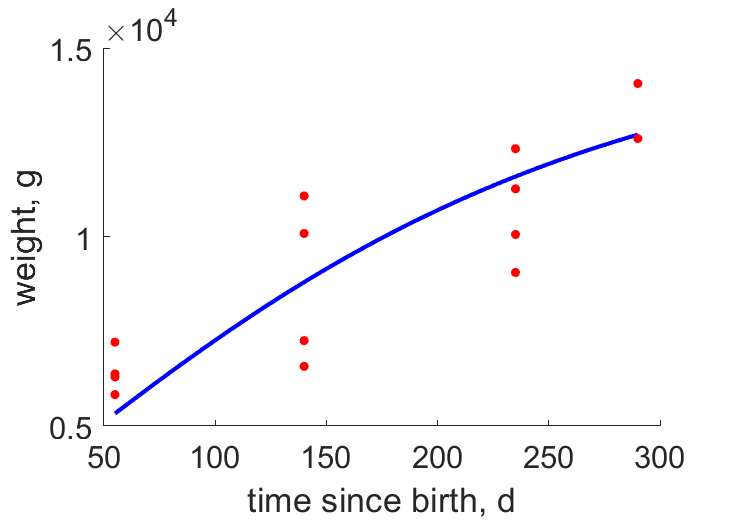Predictions & Data for this entry
| Model: stx | climate: ME | migrate: | phylum: |
| COMPLETE = 2.5 | ecozone: MIS, MPS | food: bxM, xiCvf, xiCic | class: |
| MRE = 0.062 | habitat: 0iMc | gender: Dg | order: |
| SMSE = 0.010 | embryo: Tv | reprod: O | family: |
Zero-variate data
| Data | Observed | Predicted | (RE) | Unit | Description | Reference |
|---|---|---|---|---|---|---|
| tg | 236 | 243.2 | (0.03062) | d | gestation time | AnAge |
| tx | 335 | 334.6 | (0.001319) | d | time since birth at weaning | AnAge |
| tp | 1825 | 1722 | (0.05627) | d | time since birth at puberty | AnAge |
| tpm | 1825 | 1823 | (0.0009395) | d | time since birth at puberty | AnAge |
| am | 1.117e+04 | 1.118e+04 | (0.00083) | d | life span | AnAge |
| Wwb | 3600 | 3594 | (0.001624) | g | wet weight at birth | AnAge |
| Wwi | 4e+04 | 4.155e+04 | (0.03872) | g | ultimate wet weight for females | AnAge |
| Wwim | 1.26e+05 | 1.258e+05 | (0.001393) | g | ultimate wet weight for males | Wiki |
| Ri | 0.00274 | 0.002652 | (0.03214) | #/d | maximum reprod rate | AnAge |
Uni- and bivariate data
| Data | Figure | Independent variable | Dependent variable | (RE) | Reference |
|---|---|---|---|---|---|
| tW |  | time since birth | weight | (0.141) | Matt1981 |
Pseudo-data at Tref = 20°C
| Data | Generalised animal | Arctocephalus forsteri | Unit | Description |
|---|---|---|---|---|
| v | 0.02 | 0.024 | cm/d | energy conductance |
| kap | 0.8 | 0.5568 | - | allocation fraction to soma |
| kap_R | 0.95 | 0.95 | - | reproduction efficiency |
| p_M | 18 | 17.33 | J/d.cm^3 | vol-spec som maint |
| k_J | 0.002 | 0.002 | 1/d | maturity maint rate coefficient |
| kap_G | 0.8 | 0.7997 | - | growth efficiency |
Discussion
- Males are assumed to differ from females by {p_Am} and E_Hp only
- Male {p_Am} jumps upward at puberty, as discussed in Kooy2014 under type A acceleration
Acknowledgment
- The creation of this entry was supported by the Norwegian Science Council (NFR 255295)
Bibliography